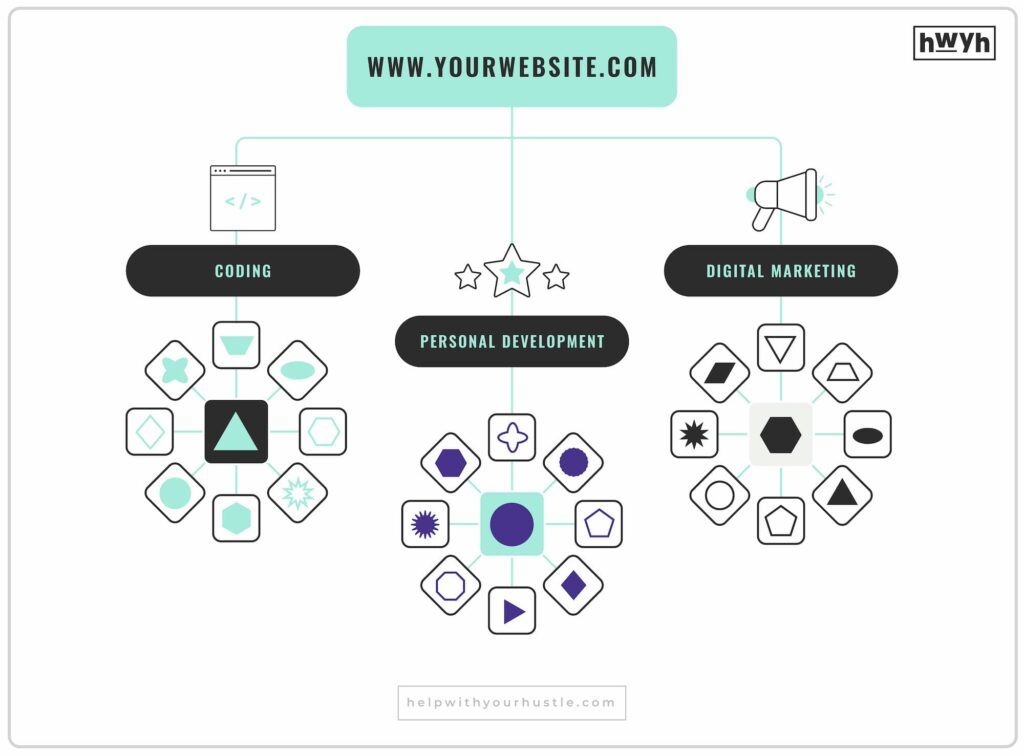Today’s lesson discusses the 5 Advanced SEO tips that will cement your knowledge as an intermediate-level SEO.
With everything you’ve gleaned from the previous four lessons combined with this insight, you realistically could apply for an entry-level SEO position at an agency somewhere and have a decent shot.
Or better yet, apply all this to your content going forward and become the digital tycoon you were born to be.
SEO Tip #1 One Page Can Rank For Many Terms
In yesterday’s lesson, you learned the importance of adding a variety of similar-but-different keywords to your article’s H2 and H3 headers (ie. answer related questions about your topic, including plurals, remembering to use natural-sounding language).
Why is this important?:
Besides avoiding keyword stuffing penalties, it’s helpful to visualize that there are many different ways someone can search for the same thing.
A well-optimized article should satisfy the search no matter how it was typed.
Example:
Imagine someone searches “javascript animation”…presumably they do so because they want to learn how to add an animation to their website using javascript.
Keyword research will unveil that this term was searched 700 times last month and has a difficulty score of 45-out-of-100 to rank on page 1.
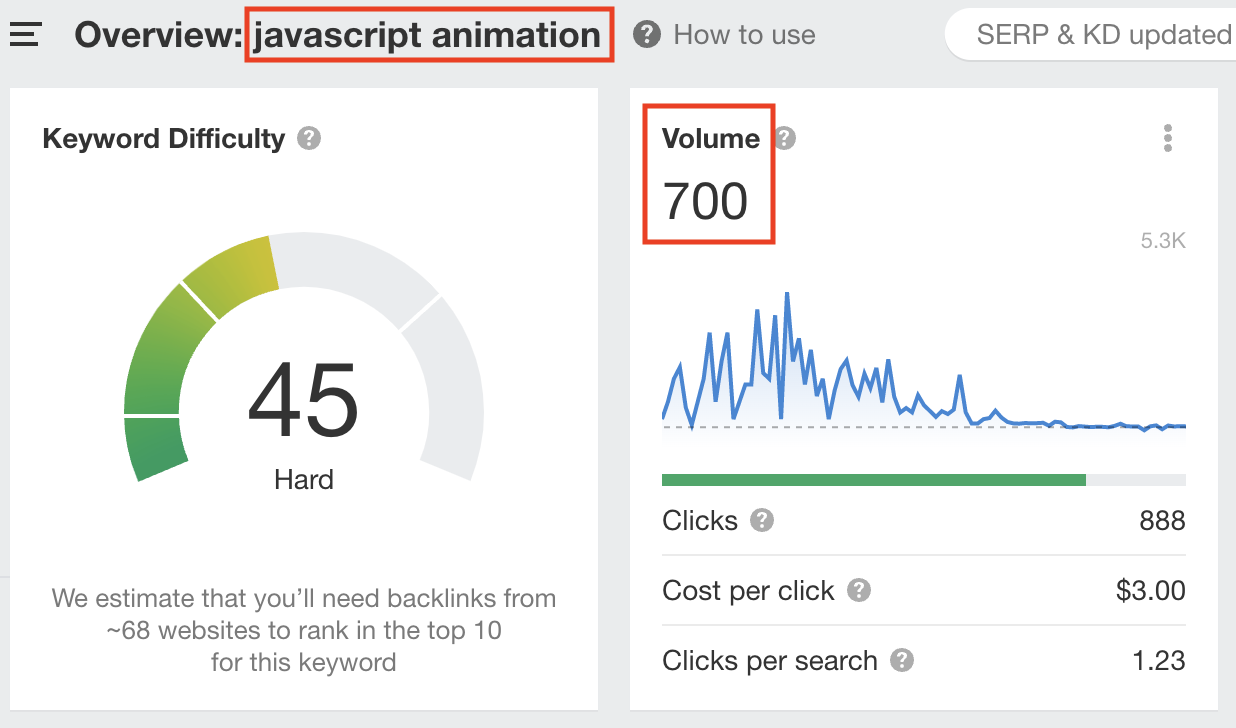
When analyzing the URL of the top result, we’ll also learn that despite the term being searched only 700 times, the page itself receives 1,300 monthly organic traffic.
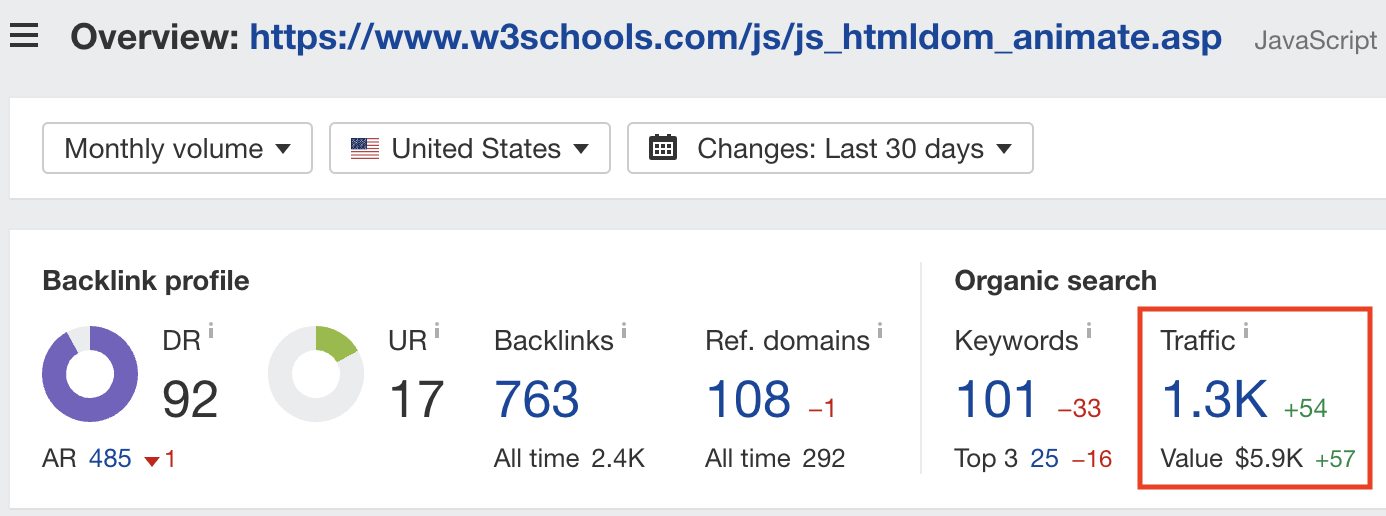
Why the discrepancy? How is it possible to receive more traffic than there are searches?
Because there are multiple ways to search for the same thing, and this article ranks #1 for most of them. ????
This is why it’s hugely important to always aim to solve the searcher’s problem first and foremost.
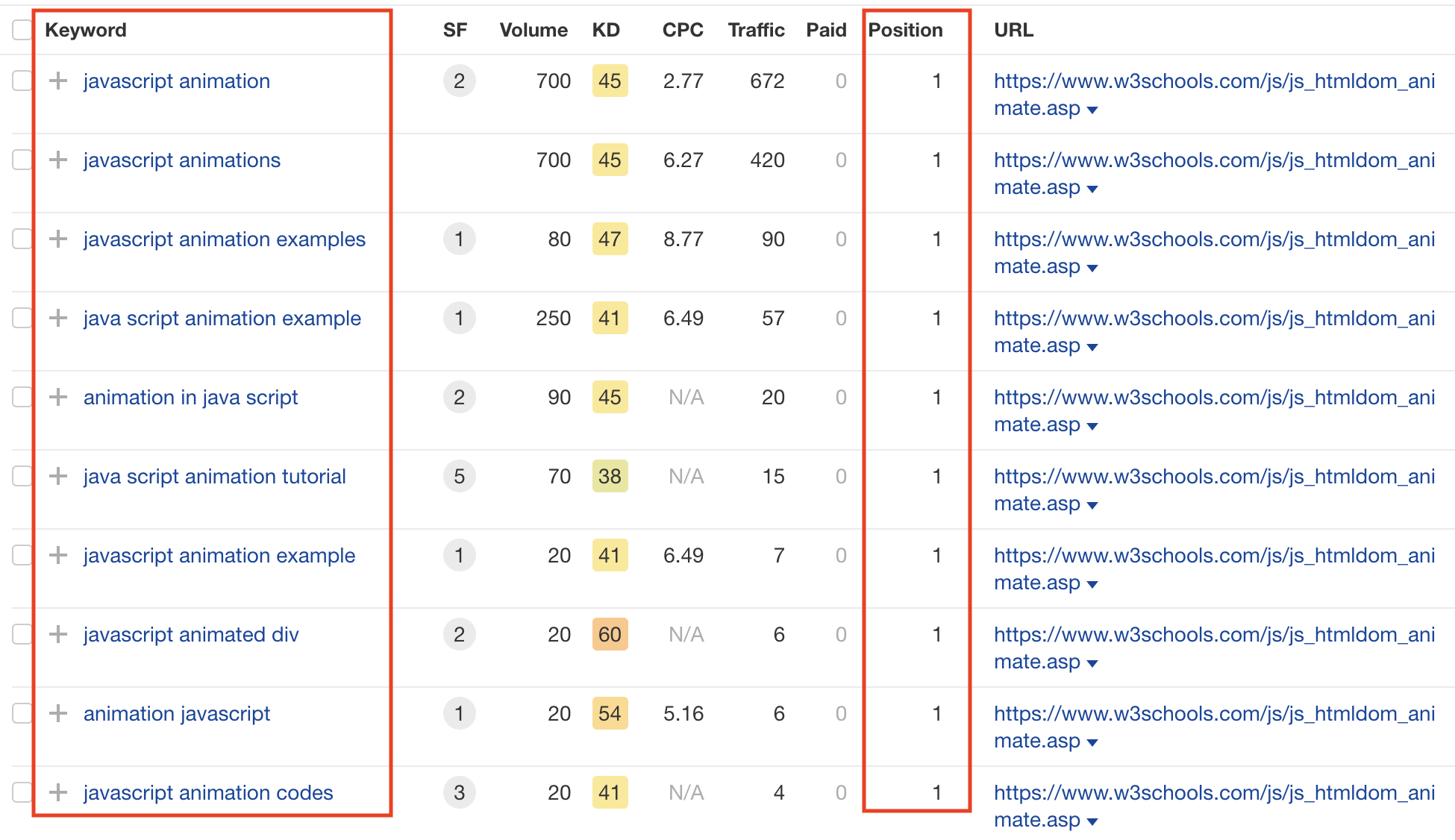
This should dissuade you from feeling tempted to stuff one specific keyword throughout your post.
By aiming to diversify your headers, you open the door to more possible ways for people to find you.
SEO Tip #2 Plan Around Topic Clusters
Topic Clusters are the game-changer we’re always surprised there is so little content on.
It’s the concept of organizing your content in a logical way that makes it easier for Google to interpret, and thus, rank you for.
Simply explained, there should be one main article that links both to and from other complimentary articles.
If you’re writing an “Ultimate Guide to X” (called Pillar Content), it should link outward to other articles in the same category.
For example, “The Best Tools to Achieve Y” or “Things No One Tells You About Z” (called Cluster Content).
The cluster content should then link back to the Ultimate Guide.
It looks like this:
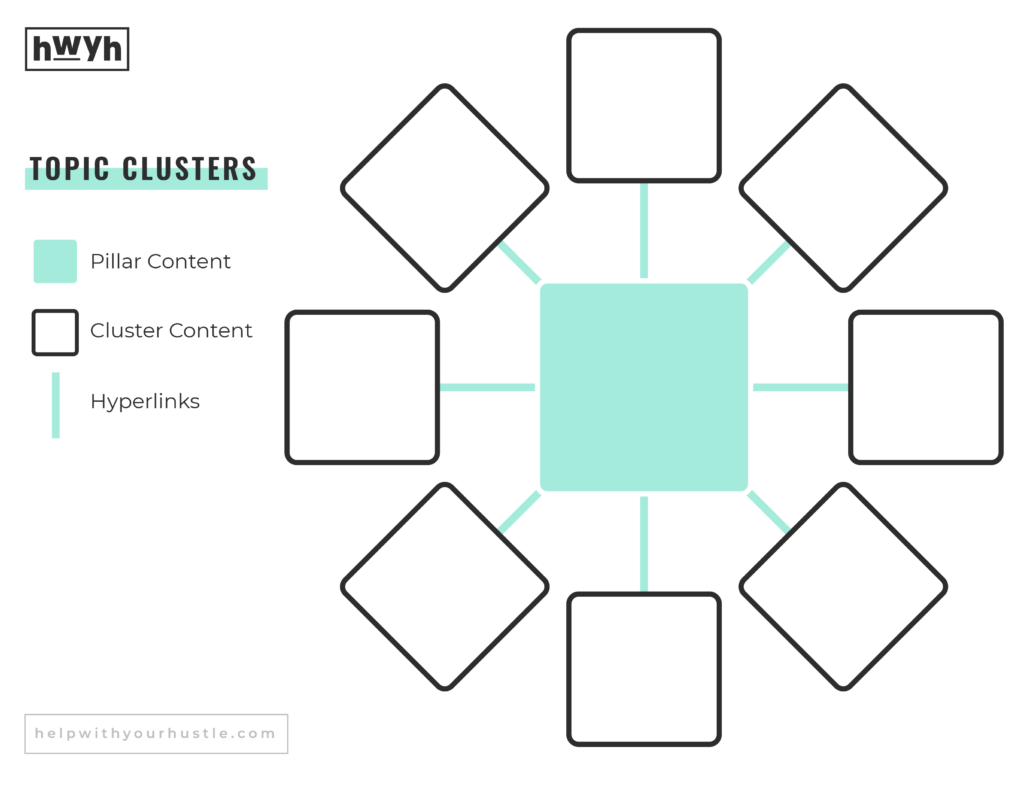
Why Use Topic Clusters?
Besides just being DOWNRIGHT FUN, there’s a good reason why Google will love you for doing this:
It makes their job easier to do.
When their job is easier to do, there’s less chance they’ll misinterpret your intentions and a much higher chance you’ll get ranked the way you want to.
You’ll get priority over your competitors who haven’t done the same work.
Internal Linking Signals
During Lesson 2 of this series you learned that Internal Links are a ranking factor, in addition to backlinks, time on page, etc.
Google loves internal links because it helps them determine “is this a useful thing to keep showing people?”
The way they look at it is, if someone finds your article, looks at it for 2 seconds, and leaves without clicking anything, it wasn’t a useful experience for the user.
BUT
If they look at it for 5 minutes, open a dozen tabs, read THOSE for 5 minutes, bookmark them, and share them? “…damn, this must be some great content!”
Linking within topic cluster format gives a reader of one article good reason to click on to other articles.
If they’re interested in this topic, why wouldn’t they be interested in the accompanying article you linked to from it?
Their engagement will show Google that yes, this is good material, and yes, they should continue to rank it higher and higher.
Makes It Easy for Google to Understand
When many articles on a similar topic all link to the same central article that encompasses them all, it’s clear to Google that the article in the center is the best one for solving the searcher’s intent on the subject.
Here’s the explanation:
Say you’ve written 26 articles on 3 different subjects: Coding, Personal Development, and Digital Marketing.
Without your taking the effort to internally link them, Google will look at the code of your articles and see this:
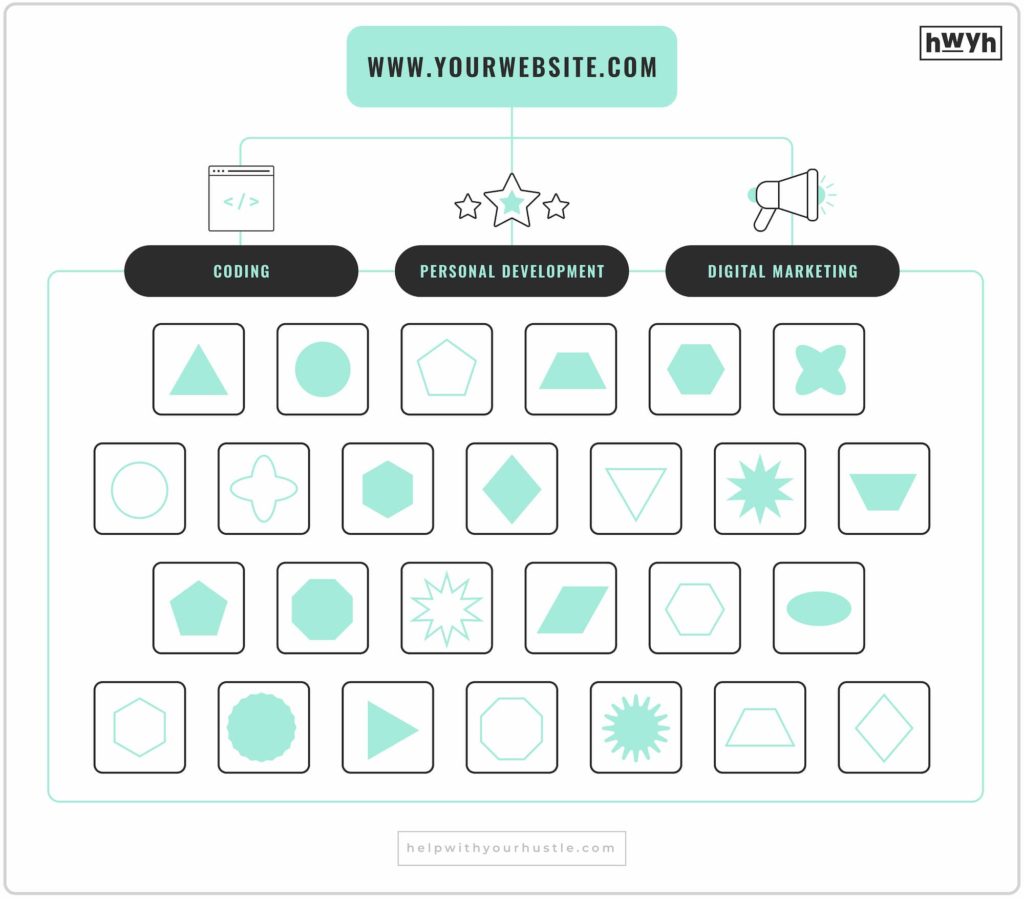
To you, this might be fine. If you wrote all of these articles, you can probably remember which were important, which were the best, the most helpful, and the ones you’d recommend the highest.
But Google is a robot. It’s a machine. An incredibly smart machine, but still a machine nonetheless.
It can’t think the same way you can. It needs your help to organize and interpret which articles are in fact, the best and most helpful, and which ones they’d recommend the highest.
When you cluster your content appropriately, it cleans up and organizes your code.
This makes it easy for them to see that (using this example) there are 3 main topics you write about and 3 really excellent articles that best represent your work.
If someone’s interested in coding, the links from the outer articles indicate that the central one is clearly your best article on coding.
If someone’s interested in Personal Development or Digital Marketing, they know your best article to send them to.
Furthermore, because the topics are linked to one another logically, there’s a much higher chance your reader will be interested in moving around the site and reading more of what you have to say.

The Best Way to Outline Your Topic Cluster
SEO Tip: start by writing your main “Pillar Content” article first, and let the supplementary “cluster content” articles naturally come from the text you write.
For example: If your main article is Why I Love Living in Portland, Oregon you’ll write your main article about all the reasons why you love calling Portland your home.
Within that main pillar article, you might naturally say you love the food, the nightlife, the proximity to the outdoors, and so on.
By the nature of writing that one pillar article, great topics for your cluster articles will naturally arise, and they all will naturally make sense to link to (and from) the original.
For example:
Pillar Content: Why I Love Living in Portland, Oregon
Cluster Content: The Best Places to Eat in Portland
Cluster Content: Why Portland Nightlife is the Best
Cluster Content: The Best Places to Hike Within 30 Minutes of Portland
Wash, rinse, and repeat until you have a network of linked, useful, and intuitively structured content.
Just start with your main article. Make it as good as it possibly can be.
Don’t try to fit all your cluster content into this main article or it will feel forced and make for a less-useful article.
Only after it’s been written, read it over and look for natural places to link to additional content.
Think something you mentioned could use more clarification? This is where you write the article that explains it.
This same concept applies whether you’re starting with entirely new content or organizing content that’s already written.
It makes for a good user experience, which is ultimately what Google wants.
If you’ve already got content that’s not linked together in clusters — start with identifying the categories you write around, then locate the “most important” articles for each category (likely those that drive the most traffic).
Read them through and look for ways to link to your other content within the same categories.
Recap: When writing supplementary “cluster content” articles, be sure that within each there is an internal link back to your main “Pillar Content” article as well.

SEO Tip #3 Drip Campaigns Keep Content in Circulation
You might hear lots of marketers talking about the importance of having a newsletter.
We agree they’re very good ways of keeping in touch with your audience and allow you to provide them with value that keeps you top-of-mind as the person who can help them with your specific problems.
It’s smart for SEO too.
Something that’s probably happened to every website out there is they write content that just ends up in the content graveyard.
Perhaps the company will do a shoutout on social media once, drive a few clicks to it, and that’s where it remains until the end of its days.
Remember, Google uses people’s engagement to help determine if this particular article is any good.
If nobody ever finds it, they’ll never be able to engage with it.
The best solution? Share it as much as possible, both on Social Media and through your email marketing channels to keep them alive.
For this course, we use Convertkit to automatically “drip” each of these articles to those who have signed up.
This keeps a consistent churn of people visiting and engaging with each of the posts.
SEO Tip #4 Fundamentally Understand Backlinks
Backlinks are wildly important, but they’re also wildly hard to acquire.
Unless you’re trying to focus on highly competitive terms, they’re not worth the time and effort of going out and looking for them.
Furthermore, the more advanced Google’s algorithm becomes, backlinks will become less and less necessary.
Think about it:
Google’s goal is to show the best articles to solve a problem for their users. Currently, the way they have to do it is to assume that whoever has the most backlinks = the best article.
If the best article in the world were to genuinely get written tomorrow, they’d be doing their users a disservice by refusing to show it.
For now, they can’t make that distinction and are still relying on backlinks. As their algorithm improves (and they’re constantly improving it), they’ll rely less and less on them.
With the same amount of time you’d spend reading guides to procuring backlinks, crafting pitches, and begging for guest blog appearances, you could instead be creating and distributing content that is so amazing that people will want to link to it naturally.
Do that.
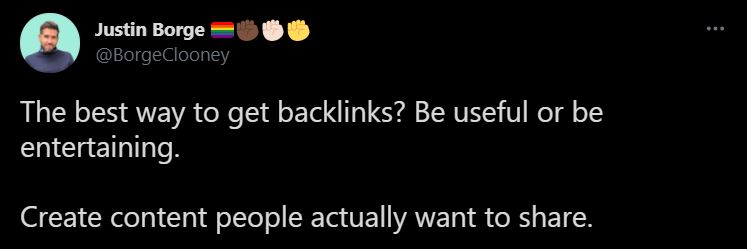
Here are some SEO tips for creating content that people will genuinely WANT to link to:
Contrarian Opinions
Find something that everyone assumes is the norm and post a strongly opinionated article that argues why that’s stupid and wrong.
Then do your best to share that article where those people hang out and let them discuss it. Chances are it’ll get linked to soon enough.
Infographics
Create useful images and graphics that illustrate a hard-to-explain concept. Be sure to imagine what someone searching Google Images would type in while looking for it, then name it that.
Include that term in the alt-text and the name of the image file itself. Include it in an article that people can link to for further explanations. (This is how images end up on Google Images in the first place)
If the image helps someone else explain a concept better than they can with words, they’ll link to you.
Create Extremely Helpful Resources
If you are sincerely solving a problem for someone, they’re going to link to you. Know your audience and do your best to create the best piece of content they’ve ever seen.
If it solves their problems better than anyone else, it’ll get linked to.
Dedicate a day to distributing it in channels where your target audience hangs out to start the snowball effect.
SEO Tip #5 Prune Old Content and Avoid Broken Links
If you’ve been writing for a while, chances are you’ve got old content on your site that hasn’t been found in a long time.
It’s time to part ways with it.
Your website is no place for sentimental content. It’s not your scrapbook.
Your website is a tool to make you money. If you want, you can export those sentimental posts to a private website somewhere else. If your old content is still on your site, it’s holding you back from your goals.
Google views dead content like, “80% of the pages on this site have no clicks. That must mean this person creates a bunch of bad content.”
If you delete all the old pages, that will skew their statistics to instead say, “oh wow! 100% of the pages on this site get clicks! This person must make a bunch of GREAT content!”
Which of those two examples do you think they’d be more likely to recommend?
Important!
When you delete content, be sure that you redirect the old URL to a different page, ideally on a similar topic.
This is especially important if there are sites around the internet that have linked to that now-deleted content.
If they’re not redirected, they become flagged as “broken links”, which create a bad user experience, and will get your site penalized.
Conclusion
Learn and commit these 5 advanced SEO tips to memory and you’ll be so far ahead of the game that you won’t even recognize yourself a year from now.
Tomorrow’s lesson is the last one!
If you’re interested in how the world of SEO and content marketing are being impacted by AI and tools like ChatGPT, this one is for you.
In it, we’ll cover how the landscape of SEO is changing, and how you can stay one step ahead of the game.
See you then!
